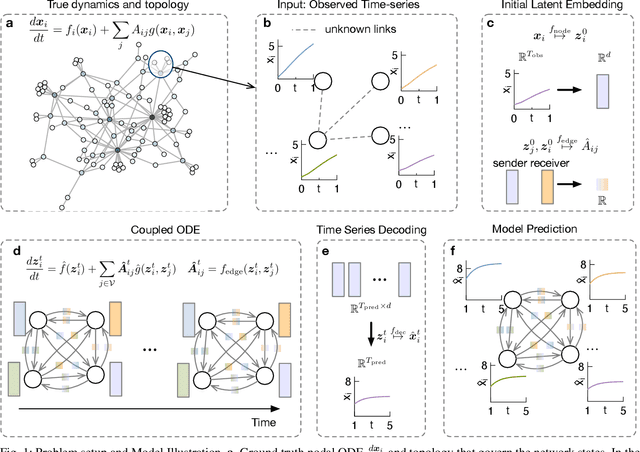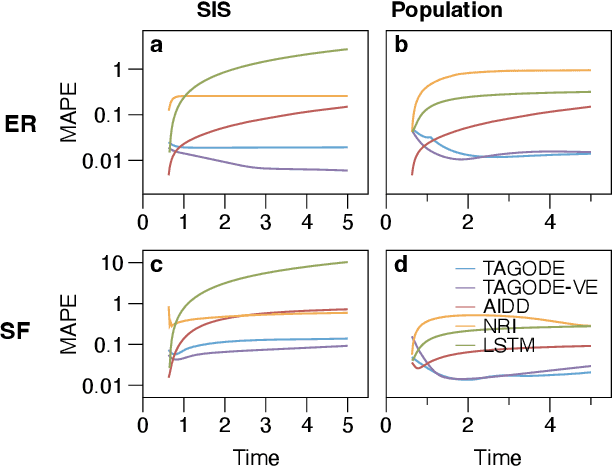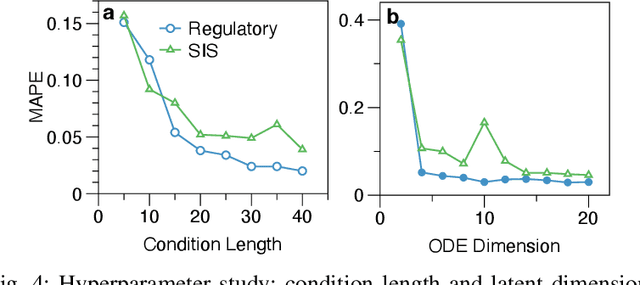Jianxi Gao
Unraveling the cognitive patterns of Large Language Models through module communities
Aug 25, 2025Abstract:Large Language Models (LLMs) have reshaped our world with significant advancements in science, engineering, and society through applications ranging from scientific discoveries and medical diagnostics to Chatbots. Despite their ubiquity and utility, the underlying mechanisms of LLM remain concealed within billions of parameters and complex structures, making their inner architecture and cognitive processes challenging to comprehend. We address this gap by adopting approaches to understanding emerging cognition in biology and developing a network-based framework that links cognitive skills, LLM architectures, and datasets, ushering in a paradigm shift in foundation model analysis. The skill distribution in the module communities demonstrates that while LLMs do not strictly parallel the focalized specialization observed in specific biological systems, they exhibit unique communities of modules whose emergent skill patterns partially mirror the distributed yet interconnected cognitive organization seen in avian and small mammalian brains. Our numerical results highlight a key divergence from biological systems to LLMs, where skill acquisition benefits substantially from dynamic, cross-regional interactions and neural plasticity. By integrating cognitive science principles with machine learning, our framework provides new insights into LLM interpretability and suggests that effective fine-tuning strategies should leverage distributed learning dynamics rather than rigid modular interventions.
Gradient Flow Matching for Learning Update Dynamics in Neural Network Training
May 26, 2025Abstract:Training deep neural networks remains computationally intensive due to the itera2 tive nature of gradient-based optimization. We propose Gradient Flow Matching (GFM), a continuous-time modeling framework that treats neural network training as a dynamical system governed by learned optimizer-aware vector fields. By leveraging conditional flow matching, GFM captures the underlying update rules of optimizers such as SGD, Adam, and RMSprop, enabling smooth extrapolation of weight trajectories toward convergence. Unlike black-box sequence models, GFM incorporates structural knowledge of gradient-based updates into the learning objective, facilitating accurate forecasting of final weights from partial training sequences. Empirically, GFM achieves forecasting accuracy that is competitive with Transformer-based models and significantly outperforms LSTM and other classical baselines. Furthermore, GFM generalizes across neural architectures and initializations, providing a unified framework for studying optimization dynamics and accelerating convergence prediction.
CRAFT: Training-Free Cascaded Retrieval for Tabular QA
May 21, 2025Abstract:Table Question Answering (TQA) involves retrieving relevant tables from a large corpus to answer natural language queries. Traditional dense retrieval models, such as DTR and ColBERT, not only incur high computational costs for large-scale retrieval tasks but also require retraining or fine-tuning on new datasets, limiting their adaptability to evolving domains and knowledge. In this work, we propose $\textbf{CRAFT}$, a cascaded retrieval approach that first uses a sparse retrieval model to filter a subset of candidate tables before applying more computationally expensive dense models and neural re-rankers. Our approach achieves better retrieval performance than state-of-the-art (SOTA) sparse, dense, and hybrid retrievers. We further enhance table representations by generating table descriptions and titles using Gemini Flash 1.5. End-to-end TQA results using various Large Language Models (LLMs) on NQ-Tables, a subset of the Natural Questions Dataset, demonstrate $\textbf{CRAFT}$ effectiveness.
Less is More: Efficient Weight Farcasting with 1-Layer Neural Network
May 05, 2025Abstract:Addressing the computational challenges inherent in training large-scale deep neural networks remains a critical endeavor in contemporary machine learning research. While previous efforts have focused on enhancing training efficiency through techniques such as gradient descent with momentum, learning rate scheduling, and weight regularization, the demand for further innovation continues to burgeon as model sizes keep expanding. In this study, we introduce a novel framework which diverges from conventional approaches by leveraging long-term time series forecasting techniques. Our method capitalizes solely on initial and final weight values, offering a streamlined alternative for complex model architectures. We also introduce a novel regularizer that is tailored to enhance the forecasting performance of our approach. Empirical evaluations conducted on synthetic weight sequences and real-world deep learning architectures, including the prominent large language model DistilBERT, demonstrate the superiority of our method in terms of forecasting accuracy and computational efficiency. Notably, our framework showcases improved performance while requiring minimal additional computational overhead, thus presenting a promising avenue for accelerating the training process across diverse tasks and architectures.
Forecasting Open-Weight AI Model Growth on Hugging Face
Feb 21, 2025Abstract:As the open-weight AI landscape continues to proliferate-with model development, significant investment, and user interest-it becomes increasingly important to predict which models will ultimately drive innovation and shape AI ecosystems. Building on parallels with citation dynamics in scientific literature, we propose a framework to quantify how an open-weight model's influence evolves. Specifically, we adapt the model introduced by Wang et al. for scientific citations, using three key parameters-immediacy, longevity, and relative fitness-to track the cumulative number of fine-tuned models of an open-weight model. Our findings reveal that this citation-style approach can effectively capture the diverse trajectories of open-weight model adoption, with most models fitting well and outliers indicating unique patterns or abrupt jumps in usage.
Modular Prompt Learning Improves Vision-Language Models
Feb 19, 2025Abstract:Pre-trained vision-language models are able to interpret visual concepts and language semantics. Prompt learning, a method of constructing prompts for text encoders or image encoders, elicits the potentials of pre-trained models and readily adapts them to new scenarios. Compared to fine-tuning, prompt learning enables the model to achieve comparable or better performance using fewer trainable parameters. Besides, prompt learning freezes the pre-trained model and avoids the catastrophic forgetting issue in the fine-tuning. Continuous prompts inserted into the input of every transformer layer (i.e. deep prompts) can improve the performances of pre-trained models on downstream tasks. For i-th transformer layer, the inserted prompts replace previously inserted prompts in the $(i-1)$-th layer. Although the self-attention mechanism contextualizes newly inserted prompts for the current layer and embeddings from the previous layer's output, removing all inserted prompts from the previous layer inevitably loses information contained in the continuous prompts. In this work, we propose Modular Prompt Learning (MPL) that is designed to promote the preservation of information contained in the inserted prompts. We evaluate the proposed method on base-to-new generalization and cross-dataset tasks. On average of 11 datasets, our method achieves 0.7% performance gain on the base-to-new generalization task compared to the state-of-the-art method. The largest improvement on the individual dataset is 10.7% (EuroSAT dataset).
Inferring from Logits: Exploring Best Practices for Decoding-Free Generative Candidate Selection
Jan 28, 2025



Abstract:Generative Language Models rely on autoregressive decoding to produce the output sequence token by token. Many tasks such as preference optimization, require the model to produce task-level output consisting of multiple tokens directly by selecting candidates from a pool as predictions. Determining a task-level prediction from candidates using the ordinary token-level decoding mechanism is constrained by time-consuming decoding and interrupted gradients by discrete token selection. Existing works have been using decoding-free candidate selection methods to obtain candidate probability from initial output logits over vocabulary. Though these estimation methods are widely used, they are not systematically evaluated, especially on end tasks. We introduce an evaluation of a comprehensive collection of decoding-free candidate selection approaches on a comprehensive set of tasks, including five multiple-choice QA tasks with a small candidate pool and four clinical decision tasks with a massive amount of candidates, some with 10k+ options. We evaluate the estimation methods paired with a wide spectrum of foundation LMs covering different architectures, sizes and training paradigms. The results and insights from our analysis inform the future model design.
Differentiable Prompt Learning for Vision Language Models
Dec 31, 2024



Abstract:Prompt learning is an effective way to exploit the potential of large-scale pre-trained foundational models. Continuous prompts parameterize context tokens in prompts by turning them into differentiable vectors. Deep continuous prompts insert prompts not only in the input but also in the intermediate hidden representations. Manually designed deep continuous prompts exhibit a remarkable improvement compared to the zero-shot pre-trained model on downstream tasks. How to automate the continuous prompt design is an underexplored area, and a fundamental question arises, is manually designed deep prompt strategy optimal? To answer this question, we propose a method dubbed differentiable prompt learning (DPL). The DPL method is formulated as an optimization problem to automatically determine the optimal context length of the prompt to be added to each layer, where the objective is to maximize the performance. We test the DPL method on the pre-trained CLIP. We empirically find that by using only limited data, our DPL method can find deep continuous prompt configuration with high confidence. The performance on the downstream tasks exhibits the superiority of the automatic design: our method boosts the average test accuracy by 2.60% on 11 datasets compared to baseline methods. Besides, our method focuses only on the prompt configuration (i.e. context length for each layer), which means that our method is compatible with the baseline methods that have sophisticated designs to boost the performance. The DPL method can be deployed to large language models or computer vision models at no cost.
Predicting Time Series of Networked Dynamical Systems without Knowing Topology
Dec 25, 2024



Abstract:Many real-world complex systems, such as epidemic spreading networks and ecosystems, can be modeled as networked dynamical systems that produce multivariate time series. Learning the intrinsic dynamics from observational data is pivotal for forecasting system behaviors and making informed decisions. However, existing methods for modeling networked time series often assume known topologies, whereas real-world networks are typically incomplete or inaccurate, with missing or spurious links that hinder precise predictions. Moreover, while networked time series often originate from diverse topologies, the ability of models to generalize across topologies has not been systematically evaluated. To address these gaps, we propose a novel framework for learning network dynamics directly from observed time-series data, when prior knowledge of graph topology or governing dynamical equations is absent. Our approach leverages continuous graph neural networks with an attention mechanism to construct a latent topology, enabling accurate reconstruction of future trajectories for network states. Extensive experiments on real and synthetic networks demonstrate that our model not only captures dynamics effectively without topology knowledge but also generalizes to unseen time series originating from diverse topologies.
Architecture-Aware Learning Curve Extrapolation via Graph Ordinary Differential Equation
Dec 23, 2024



Abstract:Learning curve extrapolation predicts neural network performance from early training epochs and has been applied to accelerate AutoML, facilitating hyperparameter tuning and neural architecture search. However, existing methods typically model the evolution of learning curves in isolation, neglecting the impact of neural network (NN) architectures, which influence the loss landscape and learning trajectories. In this work, we explore whether incorporating neural network architecture improves learning curve modeling and how to effectively integrate this architectural information. Motivated by the dynamical system view of optimization, we propose a novel architecture-aware neural differential equation model to forecast learning curves continuously. We empirically demonstrate its ability to capture the general trend of fluctuating learning curves while quantifying uncertainty through variational parameters. Our model outperforms current state-of-the-art learning curve extrapolation methods and pure time-series modeling approaches for both MLP and CNN-based learning curves. Additionally, we explore the applicability of our method in Neural Architecture Search scenarios, such as training configuration ranking.
 Add to Chrome
Add to Chrome Add to Firefox
Add to Firefox Add to Edge
Add to Edge